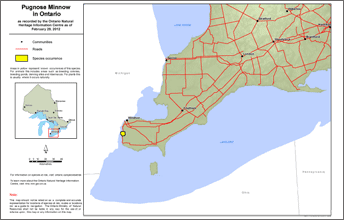Pugnose minnow
Scientific name: Opsopoeodus emiliae

Photo: Joseph R. Tomelleri
Status
Threatened
"Threatened" means the species lives in the wild in Ontario, is not endangered, but is likely to become endangered if steps are not taken to address factors threatening it.
Date added to the Species at Risk in Ontario List
The Pugnose Minnow was already assessed as special concern when the Endangered Species Act took effect in 2008. It was reassessed as threatened in 2012.
Read the assessment report.
What it looks like
The Pugnose Minnow is a slender, silvery-coloured fish about five centimetres long with a forked tail. It has a black lateral band and the scales on its back and side are distinctly outlined, with translucent straw coloured or olive overtones. The rounded snout and small upturned mouth accounts for the name pugnose.
The Pugnose Minnow feeds mainly on aquatic insects such as midges, but also eats aquatic crustaceans, fish eggs and fish fry. The up-turned mouth suggests that the Pugnose Minnow is a mid-water or near-surface feeder.
This species has a unique spawning behaviour. In late spring, males select a flat surface for the spawning site, such as the underside of a flat rock, and lead the females to the site. Females lay eggs on the underside of this surface and the males then guard the nest and eggs from predators. Eggs are laid singly or in strings of two to five in a single layer. Up to 120 eggs can be laid per spawning session, which is repeated over six to seven days.
Where it lives
The Pugnose Minnow prefers coastal wetlands, and slow-moving rivers and streams with clear, warm water, little or no current, and abundant vegetation.
Where it’s been found in Ontario
The Pugnose Minnow lives in central North America in the rivers and streams of the Mississippi River basin. Its range extends from South Carolina and Florida west to Texas and north to Wisconsin. In Canada, it is at the northern limit of its range and is only found in extreme southwestern Ontario with small populations in Lake St. Clair and the Detroit River.
View a larger version of this map (PDF)
What threatens it
The main threat to this species is habitat alteration and siltation of rivers and streams due to agricultural practices and urban development, resulting in loss of well-vegetated habitats.
Action we are taking
Threatened species and their general habitat are automatically protected under Ontario’s Endangered Species Act, 2007.
Recovery strategy
A recovery strategy advises the ministry on ways to ensure healthy numbers of the species return to Ontario.
Read the executive summary and the full document (July 12, 2023).
Habitat protection
General habitat protection — January 24, 2013
Government response statement
A government response statement outlines the actions the government intends to take or support to help recover the species.
Read the government response statement (April 17, 2024).
What you can do
Report a sighting
- Report a sighting of an endangered animal or plant to the Natural Heritage Information Centre. Photographs with specific locations or mapping coordinates are always helpful.
Volunteer
- Volunteer with your local nature club or provincial park to participate in surveys or stewardship work focused on species at risk.
Be a good steward
- Private land owners have a very important role to play in species recovery. If you find a nesting on your land, you may be eligible for stewardship programs that support the protection and recovery of species at risk and their habitats.
Report illegal activity
- Report any illegal activity related to plants and wildlife to
Toll-free: 1-866-MOE-TIPS (663-8477) .
Quick facts
- Pugnose Minnows have a lifespan of about three years.
- Breeding males develop small white knobs on the first three dorsal fin rays and patches of small tubercles on the snout and chin. These small white knobs may act as egg mimics to stimulate the female to spawn.
